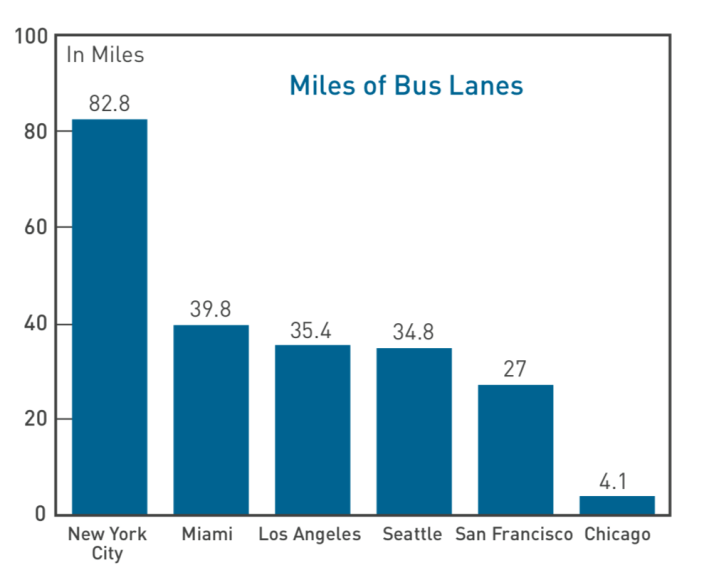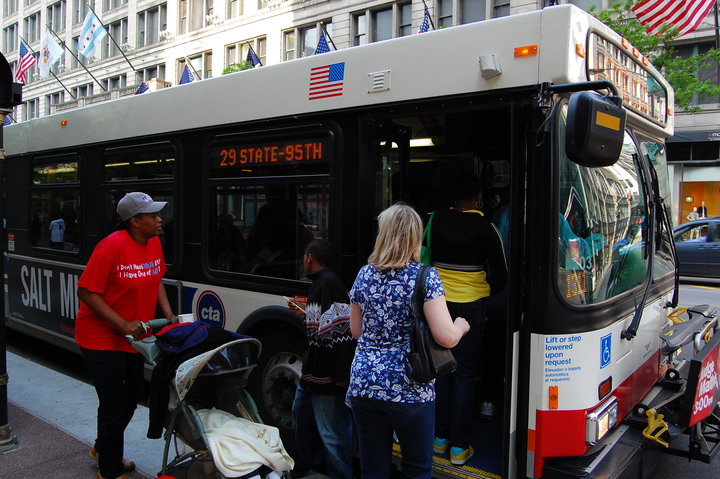The Active Transportation Alliance's new study on boosting bus ridership, funded by the TransitCenter foundation, recommends that CTA bus lines across the city should be sped up using a combination of priority at intersections, dedicated lanes, and decreasing the time it takes for people to board. The group also proposed specific upgrades for six different routes.
The report, "Back on the Bus" [PDF], analyzes the factors behind the trend towards declining ridership on CTA buses, which still carry more than half of the system's customers. To stem the loss, and increase safety and efficiency on Chicago streets, major improvements to bus reliability and speed are needed.
The study highlights exactly where and how Active Trans recommend making changes to speed up each route, some of which I'll discuss in detail. While bus-only lanes would have the greatest effect on reducing travel times, reducing bunching, and generally improving reliability, Chicago currently has only four miles of them. Other cities in the United States have several times that amount. New York City has twenty times as many , Miami has ten times as many, and San Francisco has seven times as many.
Active Transportation Alliance recommends bus lanes for three of the six routes, but governmental relations director Kyle Whitehead, the lead author of the study, says that "the upgrades we suggested for those routes are also relevant elsewhere in the bus network."
Changes that add bus lanes, bypass lanes, or priority at traffic signals, would involve the Chicago Department of Transportation. Signal upgrades are very expensive. The Regional Transportation Authority, which oversees the CTA, got a $40 million grant to pay for signal priority upgrades on parts of Ashland and Western Avenues, and for certain Pace routes in the suburbs.
On the other hand, bus-only lanes are cheap to install, but taking away street space from drivers and dedicating it for transit use can be a heavy lift politically. For example, the city's proposal for bus rapid transit on Ashland was shelved a few years ago due to a backlash from some residents and merchants.

Cottage Grove
The CTA's #4 Cottage Grove bus begins and ends most of its trips at Chicago State University in Roseland, going all the way to or from the downtown Illinois Center. Some trips go 20 blocks further south. It's the fifth most used bus route, but ridership dropped 4.8 percent from 2014 to 2015.
Here's what ATA said should be done:
- Build bus lanes on Cottage Grove from 39th to 47th, and from 60th to 79th. Those are good, long sections, but the cross section of Cottage Grove is consistently wide and four lanes north and south of these sections. That's much more than existing traffic volumes require, so Cottage Grove could easily accommodate speedier buses on more of the street.
- Give the bus priority at intersections with 47th, the Midway Plaisance at 60th, and 79th. The report didn't have details as to how much buses are being delayed at those intersections.
The report didn't specifically recommend adding bus lanes on the six lane-wide stretch of Michigan Avenue downtown, where the #4 and many other buses also begin or end their cross-city routes. Currently far too many bus drivers are slowed down here by traffic jams created by solo drivers.
Halsted
The #8 Halsted bus runs between Auburn Gresham to the south and Lake View to the north, carrying the third highest number of riders. However, ridership has dropped 6.5 percent. What can be done?
- Build a bypass lane at the Lincoln/Fullerton/Halsted intersection in Lincoln Park, with traffic signal priority. This would mean that the Chicago Department of Transportation would have to get rid of one of its turn lanes for cars.
- Build bus lanes between 35th and Garfield (55th)
- Build bus lanes between Harrison and Roosevelt. This section is very short (only half a mile), but buses make a lot of stops here to pick up and drop off University of Illinois at Chicago students and staff. Buses are constantly hindered by car traffic and people parking in bus stops.
Pulaski
The #53 Pulaski bus runs on Pulaski Avenue between Little Village and North Park, carrying the seventh highest number of riders, but ridership has dropped 6.7 percent. The route serves four CTA 'L' stations and one Metra station. What does ATA recommend?
- No bus lanes were proposed, but there could be three bypass lanes at the intersections with Irving Park Road, Division Street, and 31st Street
- The CTA should speed up boarding at the Pulaski Orange Line station. This could be done using the bullpin-style prepaid boarding area method that is currently being tested at the Belmont Blue Line station, or through all-door boarding.
Chicago
The #66 Chicago bus between the Austin neighborhood and Navy Pier, andit's the city's second-most used route. Ridership has dropped 4.2 percent. In the morning, going eastbound towards downtown, buses come as frequently as every three minutes, but they're slowed down by all the car traffic.
- ATA recommends building bus lanes on Chicago between California Avenue (2800 west) and Fairbanks Court (250 east), but not the four block section between Larrabee and Franklin.
- Build a bypass lane at Chicago/Western and at Chicago/Milwaukee/Ogden, where there's a Blue Line stop.
- Speed up boarding at the Blue Line station. This is a no brainer - 2,118 people boarded the bus here, in both directions, on an average weekday in October 2016.
79th
The #79 79th bus runs between Ford City Mall in West Lawn and South Shore, and it's the most used bus route. The route isn't any different from the others here: ridership has dropped 5.1 percent. This is what ATA recommends:
- Build bypass lanes at the intersections with Halsted, Ashland, and at the Dan Ryan Expressway (where the Red Line station is). The report didn't recommend any bus lanes.
- Speed up boarding at the 79th Street Red Line station, where more than 4,000 people board per day.
Irving Park
The #80 Irving Park bus runs between the O'Hare community area and Uptown/Lakeview. It's not in the same class as the others, carrying only the 27th highest number of people, but it had a large ridership drop of 8.2 percent. ATA recommended the following:
- A very short bus lane between Clark and Sheridan, past Graceland Cemetery. There were no other bus lane recommendations. Irving Park Road has two lanes in each direction, consistently, but much more personal and commercial vehicle traffic than the other streets in the report – up to 46,500 cars per day, according to the report.
- Bypass lanes at the intersections with Lincoln/Damen, and at the Irving Park Blue Line station, at Pulaski and the Kennedy Expressway.
Take action
If you want these proposals to become more than just recommendations in a report, you should email the report to your alder, or print it out and drop it off (it's only 24 pages), and ask them to support the plan, especially changes recommended within the ward.






